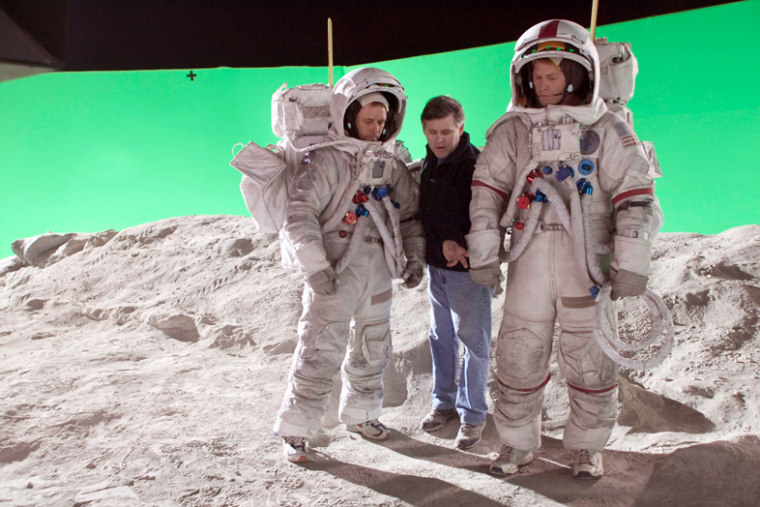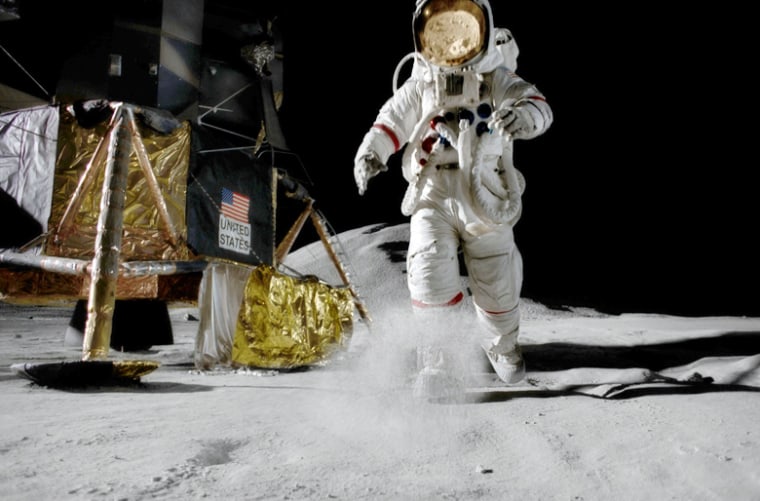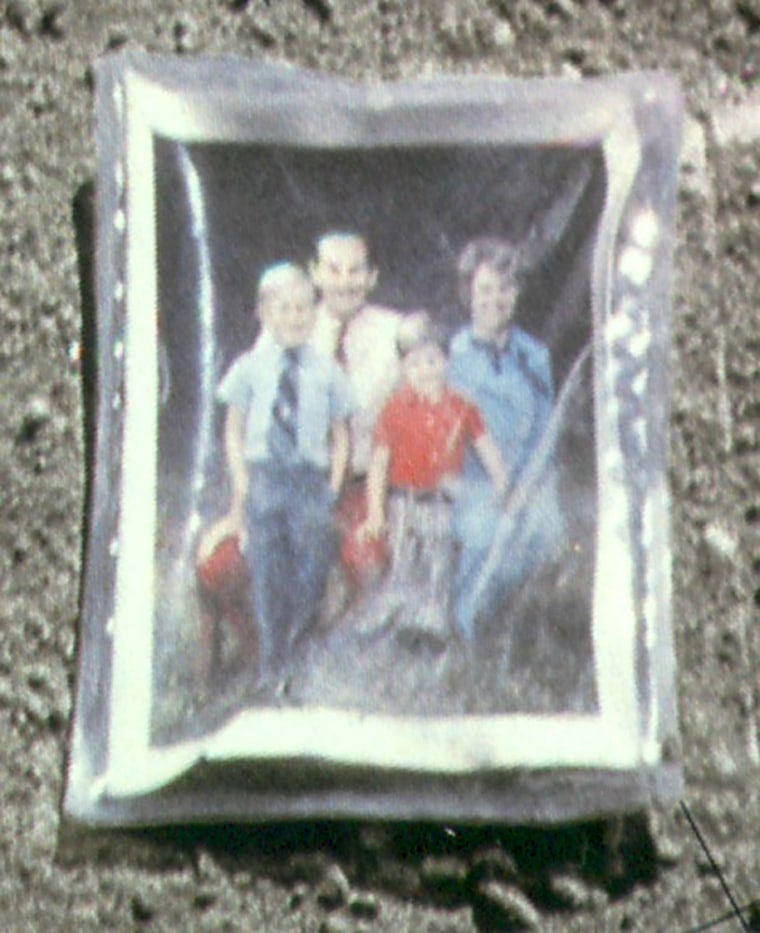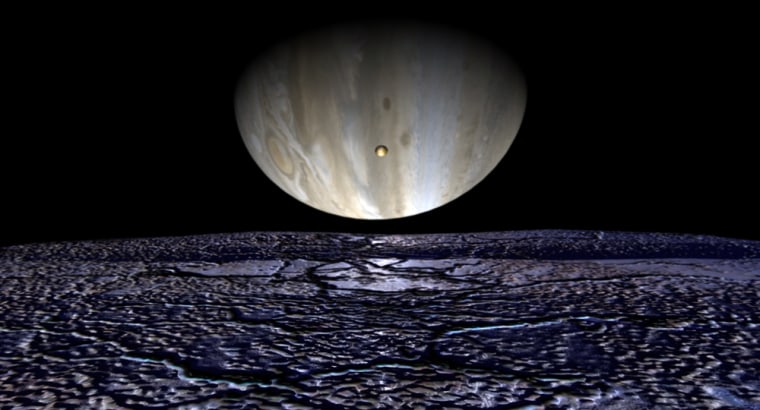• Sept. 23, 2005 |
‘Cosmos’ reborn at 25: Back in 1980, the world was in a muddle: The United States was struggling with an "evil empire" and knotty problems in Afghanistan as well as Iran and Iraq. Scientists debated whether or not humans were contributing to a "greenhouse effect" similar to that seen on the planet Venus. And an astronomer from Cornell University who worked on that Venusian research, among other things, stepped out as the host of a most unusual public-TV series titled "Cosmos."
"For the first time, we have the power to decide the fate of our planet and ourselves," Carl Sagan declared at the top of the show. "This is a time of great danger, but our species is young, and curious, and brave. It shows much promise."
Sagan passed away nine years ago — but "Cosmos" lives on, along with many of the dangers and all of the promise that he saw a quarter-century ago. Next week, the 13-part documentary series returns to television, digitally remastered and completely retooled with computer graphics reflecting our updated understanding of the cosmos.
The first two hourlong installments air Tuesday on cable television's Science Channel, kicking off the weekly series.
Ann Druyan, Sagan's widow and a co-writer of the original "Cosmos," told me she was surprised at "how enduring" the series turned out to be.
"The Science Channel has done a beautiful job of enhancing the visuals by giving new visual expression to our scripts, and leaving the greatness of Carl untouched," said Druyan, who is the chief executive officer of Cosmos Studios and one of the executive producers for the updated series.
Sagan's words have been left as is, except for the cuts required to fit the show into a commercial-friendly time slot, Druyan said. And other than a quibble over the age of the universe — the estimate has been reduced from the 15-billion-year figure cited by Sagan to 13 billion years — Druyan said the science holds up surprisingly well.
The big difference is in the artistic depictions of phenomena ranging from the birth of stars to the origin of species. Most of the graphics have been redone, and you can see the before-and-after effect in video clips available from The Science Channel's "Cosmos" Web site. One example shows a stellar nursery, which looked like a star-sprinkled haze in the original but now reflects the Hubble Space Telescope's view of evaporating gaseous globules, or EGGs.

"Every time I see an image from the Hubble, I just want to call Carl, because I think he would have been so inspired," Druyan said. "Visually, this 'Cosmos' would have gratified him and delighted him enormously."
Through the years, Druyan has received thousands upon thousands of messages expressing gratitude for the "Cosmos" shows.
"'Cosmos' is a great net that gets cast out," she said, "and years later people tell you that they’re a teacher, a scientist, they're a student of science, they do research, they're a technician because they had some gravitational brush with the 'Cosmos' television series."
But "Cosmos" was about much more than just the science, and the series' deeper message still holds after 25 years, as Druyan explained:
"Of course the world has changed. If you look at the last episode, 'Who Speaks for Earth,' at that moment we were engaged in another dangerous struggle, different from the one we're engaged in now. But there are still certain similarities: our failure to solve the issue of nuclear proliferation and the nuclear arms race. We have fewer of those weapons than we had at the time 'Cosmos' was made, and yet we still live from crisis to crisis, with a sense of impending danger."There are references to inadvertent climate modification, which are absolutely prophetic in terms of the news today, and our anxiety about what seems to be an increasingly inhospitable climate on the earth, possibly a climate that we ourselves have altered. For most people in the world, Carl Sagan was the first person to warn of these dangers."I think it's that marriage of not only the poetry of how we found out where and when we are in the universe, but also a kind of ethical, spiritual concern, which really sets 'Cosmos' apart from any other science series before or since."
Druyan admitted that she's often asked about doing a successor to the series: "When a Carl Sagan appears — someone who really has that astonishing combination of poetry, of knowledge, of ethics, of vision — then that’s the person I want to work with and do that new 'Cosmos.' I haven’t found that person quite yet."
She said part of that winning combination is the ability to speak out on the many public policy issues challenging science today, ranging from climate change to evolution education to stem cell research. "We haven’t had the reasoned debate that we deserve as a people," Druyan said.
So what will it take to get that debate?
"It will take a bunch of scientists, even maybe a handful or one scientist, who is willing to say what's true without fear of the implications for their next grant proposal," she said. "I think once you conquer that fear, as Carl did long ago, you become very powerful and very strong."
In addition to discussing the enhanced "Cosmos," Druyan provided updates on two other projects close to her heart:
- Even though June's Cosmos 1 solar sail launch ended with the loss of the spacecraft before the sail was even unfurled, Cosmos Studios and the Planetary Society are pressing on with a follow-up mission. "I'll have something to tell you about that in the next month or two," Druyan said.
- Druyan said she was collaborating with Hollywood's Martin Scorsese on a film project based on "And There Was Light," the autobiography of Jacques Lusseyran. Lusseyran, who was blinded at the age of 7, became a leader of the French Resistance who survived the Nazis' Buchenwald concentration camp.
• Sept. 23, 2005 |
Weekend field trips on the World Wide Web:
•
•
•
•
• Sept. 22, 2005 |
Unnatural disaster: The problem with natural disasters is that they seem so natural. That's the reason why people are often so underprepared for hazards such as the past month's hurricanes, or earthquakes, or the thousand natural shocks that our earth is heir to.
So says David Ropeik, who teaches risk communication at the Harvard School of Public Health and is a co-author of the book "Risk: A Practical Guide for Deciding What's Really Safe and What's Really Dangerous in the World Around You."
Reflecting on Katrina's aftermath as well as Rita's approach, Ropeik said it's not only potential hurricane victims who suffer from preparedness deficit disorder.
"The research into risk perception has found that people are less alarmed by risks that are natural, compared with risks that are human-made," he said. "So weather events, earthquakes, forest fires, the threats of volcanoes in the Pacific Northwest all evoke less alarm by their nature than if the same level of threat was human-made."
For that reason, many people resist expending the time, attention and money on the recommended measures to deal with a natural disaster — that is, drawing up a household emergency plan and assembling a disaster supply kit.
Ropeik said even governments are prone to avoid dealing with low-probability, high-consequence events, such as the type of Category 4 storm that swept over New Orleans.
"This was the Army Corps of Engineers' mistake, in my opinion," he said. "They calculated that the chances of this storm were 1 in 200 or 1 in 300 for a given year, and on that basis a lot of the federal government's preparations were predicated on the risk being very low."
Katrina's horrific aftermath appears to have had an impact on that psychological hurdle, in Washington, New Orleans and perhaps around the country. "That's the silver lining in the terrible thousand-mile-wide cloud of that storm," Ropeik said.
Ropeik pointed out that, in a sense, even natural hazards are human-influenced risks, since people choose to live in the hazard zone and should be prepared accordingly.
"If you live near a forest that might catch on fire, don't think of it as a natural risk. It's not," he said. "The very fact that you are living in a place where natural risks can occur contributes to the possibility that you might be harmed. It's not just the lightning's fault."
It might take a mental trick to change your perception of natural risks so that they compare more directly to the risks associated with, say, street crime.
"Try to think of storms and other natural threats the same way you would think of walking down a dark, scary street," he advised. "Strip away the fact that it's natural, and think of it as a human-made risk — like being mugged — because it genuinely is."
• Sept. 22, 2005 |
Quick scan of the scientific Web:
•
•
•
•
• Sept. 21, 2005 |
Techies stand up to the storm: Even as another monster hurricane is bearing down on the Gulf Coast, high-tech types are helping disaster workers cope with a flood of data: Who survived Hurricane Katrina, and who's looking for those survivors? What places haven't yet been checked? Which places are likely to provide havens from the storm, and which places are particularly hazardous?
We highlighted some of the technologies that were being employed just after Katrina hit, and during the peak of the search-and-rescue effort. Information technology emerged as a vital factor in the relief effort's successes, as well as its failures. Now those technological tools will be put to the test once again by Hurricane Rita.
In response to those earlier reports, I received some updates as well as some new twists in the high-tech response to natural disasters. For example, the Katrina Safe Web site is up and running, thanks to the American Red Cross, the San Diego Supercomputer Center, the National Institute for Urban Search and Rescue and many other supporters.
Katrina Safe brings together thousands of names from a variety of sources into one big searchable database of Katrina survivors.
"This is a perfect example of blending SDSC's high-tech data tools and expertise with traditional methods of disaster relief," data scientist Chaitan Baru of the San Diego Supercomputer Center said in a news update. "We hope to take this opportunity to use what we have learned to construct a database system to be in place even before the next disaster hits."
Robin Murphy, director of the University of South Florida's Center for Robot-Assisted Search and Rescue, also reported success in her tests of unmanned aerial vehicles in Pearlington, Miss. The camera-equipped UAVs were able to survey a cut-off part of the inundated town within two hours of getting the call, confirming that there were no survivors trapped in the area.
"We learned that seeing whether people were trapped on their roofs just beyond sight along a flooded road was critical," Murphy said in a news release. "It takes too long for manned helicopters to get there — if the radios are working."
Meanwhile, K-Y Su of the Pacific Northwest GIS Response Team wrote in from Seattle about a project that uses Geographic Information Systems data for disaster relief. The team traces its roots back to last year's Asian tsunami, Su says:
"As far as we know, this is the first major use of GIS by a non-government relief-development entity."The intended mode of operation ... is to send a field surveying team onsite; they send data back to the data center, where it is combined with and analyzed against other data sources, and we send data back to field crews where they act on it or pass it to others, and optionally can perform further analysis as the clients need."The data can, based on pre-existing conditions and water/wind information, predict likely locations of survivors, casualties, hazards, safe refuges, resources/utilities that are functional or inoperable, and alternate access routes, and match them against known positions of responders and other resources, even before the responders expend time and endurance and expose themselves to risk. In redevelopment, the same principles apply to predict areas where redevelopment is or is not possible, where resources are or are not damaged, how the land contours and shoreline are changed, where future floods or landslides are likely, and to verify where parcels and land ownership used to be."
The response team is offering its services for dealing with the aftermath of Hurricane Katrina, and is also gearing up to deal with Hurricane Rita. For an example of GIS at work, check out GIS.com and its links to a Hurricane Katrina Disaster Viewer and Storm Tracker.
• Sept. 21, 2005 |
Brane food: Following up on last week's item on why multidimensional branes may have spawned our three-dimensional world, University of Washington physicist Andreas Karch passes along a recommendation for the newly published book by his collaborator, Harvard's Lisa Randall.
The subject of Randall's book is summed up in the title: "Warped Passages: Unraveling the Mysteries of the Universe's Hidden Dimensions." You can read or even listen to (using RealAudio) an interview with Randall conducted by my colleague Robyn Williams of the Australian Broadcasting Corp.
"We could be stuck on, not a tabletop, but a surface called the brane — which is like a membrane-like object in higher dimensional space," Randall told Williams. "And maybe we’re stuck on this object that has three spatial dimensions, but there are these other dimensions of space that again we don’t directly experience but nonetheless they could have an impact on our world. Which would be very exciting."
For more about Randall and her work, check out her mini-profile in our roundup of women working on the frontiers of physics.
• Sept. 21, 2005 |
Scientific smorgasbord on the World Wide Web:
•
• (via GeekPress)
•
•
• Sept. 20, 2005 |
A contest for robo-diggers: NASA's latest "Centennial Challenge" is offering $250,000 in prizes for the country's best moondirt-digging robots.
The Regolith Excavation Challenge will take its place among four other NASA-backed contest programs, all modeled after richer competitions such as the $10 million X Prize and the $2 million DARPA Grand Challenge.
Like NASA's other prize programs, the contest announced today is aimed at encouraging the development of tools that will come in handy as the nation's space effort pushes beyond low Earth orbit, back to the moon and onward to Mars. This time, the goal is to come up with an autonomously operated system capable of excavating simulated moon dirt, or regolith, and delivering it to a collector.
"Excavation of lunar regolith is an important and necessary step toward using the resources on the moon to establish a successful base for life on its surface," Douglas Cooke, NASA's acting associate director for exploration systems, said in today's announcement. "The unique physical properties of the lunar regolith make excavation a difficult challenge."
Simulated lunar regolith is generally made from volcanic ash, with extra ingredients added to get the clumpy grit just right.
The head-to-head digging competition, tentatively planned for late 2006 or early 2007, would be decided based on how much of the dirt can be delivered in 30 minutes. Detailed rules are to be made available later this year.
NASA's partner in organizing the contest is the California Space Education and Workforce Institute. Although the space agency will provide the prize money, the contest logistics will be managed by the institute — and the institute is just starting the search for funds to cover its expenses, said spokeswoman Janice Dunn.
"What we're planning to do is have more than one level of competition," Dunn said. There would be contests for elementary and secondary school students, for college students and for professionals.
Prize levels have not yet been set, but Dunn said the institute is planning to reward the most innovative kids as well as the grown-ups. "Those bright young minds often have wonderful things to add," she said.
The dig-off dovetails with yet another NASA-backed contest: the Moon Regolith Oxygen Challenge, also known as MoonROx. That contest, managed by the Florida Space Research Institute, is aimed at encouraging the development of systems that can extract breathable oxygen from moon dirt.
Some believe real moon dirt could yield even richer resources, ranging from drinkable water to helium-3 suitable for feeding yet-to-be-built fusion reactors. But that particular paydirt is pretty far afield. If the contest really does encourage new robotic technologies for excavation, they're likely to find applications on Earth before they're applied to lunar operations.
The other Centennial Challenges announced so far include the Astronaut Glove Challenge, managed by Volanz Aerospace; and the Beam Power Challenge and the Tether Challenge, both managed by the Spaceward Foundation. Spaceward is planning to stage its first challenges Oct. 21-23, during the "Space Elevator Games" at NASA's Ames Research Center in Mountain View, Calif.
• Sept. 20, 2005 |
More scientific curiosities on the World Wide Web:
•
•
•
•
• Sept. 19, 2005 |
Return to the moon ... virtually: If you want to fake a moon landing, it's not enough to build a Hollywood moonscape and have your actors tromp around in vintage spacesuits. Nowadays, you have to put your "astronauts" on wires to duplicate the physics of the moon's one-sixth gravity. You also should go back and digitize the authentic NASA photos and films, to produce a virtual backdrop for the action.
And then comes the real trick: blending all those visuals together into a seamless 3-D whole, using the latest in computer-graphics technology.

The job may sound daunting, but it can be done. Just ask Mark Cowen, director of "Magnificent Desolation," the new Imax 3-D feature documenting the Apollo program's six missions on the lunar surface. "We knew how to rebuild the moon," he said.
Cowen and the rest of the documentary team blended imagery of the Apollo missions as well as the personal stories of the astronauts to produce a 40-minute virtual ride back to the moon. With the aid of high-tech 3-D spectacles, you see the moon as the astronauts did: an airless, eerie black-and-white wasteland that Apollo 11 moonwalker Buzz Aldrin famously described as "magnificent desolation."
"Magnificent Desolation" literally gets the red-carpet treatment during a world premiere Wednesday at the National Air and Space Museum's Lockheed Martin Imax Theater. Aldrin and other astronauts will be mixing it up with Hollywood types such as Tom Hanks, who served as the film's narrator, producer and co-writer.
It was Hanks who was the driving force behind the project, Cowen said. "Magnificent Desolation" is just the latest in a string of space-related shows for the Oscar-winning actor, who starred in the film "Apollo 13" and was executive producer for the miniseries "From the Earth to the Moon."
"Doing the movie with Tom Hanks gave us an entree to NASA unlike what I've ever seen before," Cowen recalled.
Hanks believed that the Imax 3-D format would be ideal for a "you-are-there" retelling of the Apollo saga — and Cowen, who had worked with Hanks previously on a World War II documentary, gladly joined the "Magnificent Desolation" team.
Cowen, 42, considers himself a child of the Apollo era — right down to the collection of astronaut trading cards. "I'm a space geek, and have been since I was a wee one," he said. So it was a special thrill to be directing actors on a studio moonscape the size of a football field, outfitted with replicas of the lunar module and lunar rover borrowed from the Kansas Cosmosphere and Space Center.
"Standing on the set, surrounded by what looked like the moon, I was in this directorial 'pinch-me' phase," he said.

To reproduce the one-sixth-gravity environment, the astronaut-actors were hooked up with the kinds of wire suspension systems typically used for martial-arts movies such as "Crouching Tiger, Hidden Dragon." Other low-gravity effects were duplicated by filming in slow motion, Cowen said.
The live-action sequences were supplemented by archival footage and panoramas, digitally enhanced and enlarged for Imax's six-story-high screen. Production experts used sophisticated software — including what Cowen jokingly called "geotopographical-something-or-other maps" — to add 3-D depth to the 2-D originals.
The experts also used computer graphics to smooth over seams, gaps and glitches in the original imagery. "Sometimes the tops of mountains were cut off by the astronauts during shooting," Cowen explained.
All this was aimed at giving goggle-wearing theatergoers a 3-D view of the moon that's the next best thing to being there.
"This film really is a multiformat, hybrid, documentary, experiential something," Cowen said. "We really haven't quite come up with what it is yet, but it is unique in that we are melding a number of formats. Not just pandering to Imax, but I don't know of another film format that we could have done it in."
"Magnificent Desolation" of course hits the high points of the Apollo saga — from 1969's first small steps on the moon to 1972's last bootprints. But Cowen said he and the other filmmakers didn't want to stop there.
"One of the first things we decided very early on ... was instead of creating a movie of all the classic iconic moonwalk moments that we've all seen, we would go just to the left or to the right of what we know, or what we think we know," Cowen said. "So I would say the majority of the moments in the movie are not moments that we've seen before."

The classic example is a private moment involving Apollo 16 moonwalker Charlie Duke. In the midst of his lunar mission in 1972, Duke walked off the beaten lunar track and dropped a plastic-wrapped photograph of his family on the dirt. Then he took a picture of the picture for posterity's sake.
Such moments "captured the spirit of the men who walked on the moon, and not just the rocks they picked up," Cowen said, and thus serve as the heart of "Magnificent Desolation."
"This isn't all about hopping and bopping around on the moon, and driving cool lunar rovers around the place, although we have that too," Cowen said. "This is more about the human aspect — and the fact that, as Tom Hanks says, it was the world's greatest road trip."
• Sept. 19, 2005 |
Your daily dose of science on the Web:
•
•
•
•
Looking for older items? Check the . Share your perspective on cosmic subjects with . If you link to this page, you can use or as the address. MSNBC is not responsible for the content of Internet links.
